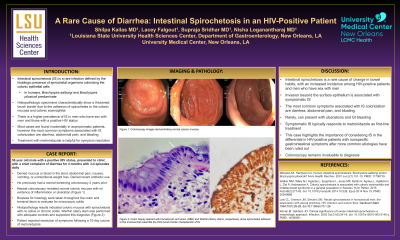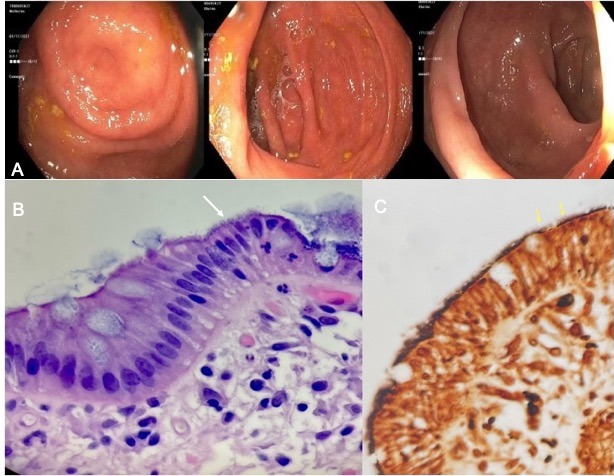Back


Poster Session D - Tuesday Morning
Category: Colon
D0159 - A Rare Cause of Diarrhea: Intestinal Spirochetosis in an HIV-Positive Patient
Tuesday, October 25, 2022
10:00 AM – 12:00 PM ET
Location: Crown Ballroom

Has Audio

Shilpa D. Kailas, MD
LSU
New Orleans, LA
Presenting Author(s)
Shilpa D. Kailas, MD1, Lacey Falgout, BS2, Supraja Sridhar, MD1, Nisha Loganantharaj, MD3
1LSU, New Orleans, LA; 2LSUHSC, Covington, LA; 3University Medical Center - LSUHSC, New Orleans, LA
Introduction: Intestinal spirochetosis (IS) is a rare infection defined by the histologic presence of spirochetal organisms colonizing the colonic epithelial cells. The most common implicated organisms are Brachyspira aalborgi or Brachyspira pilosicoli.(1) Histopathology characteristically shows a thickened brush border due to the adhesion of spirochetes to the colonic mucosa and eosinophilia. Prevalence in the general population is 2%. There is a higher prevalence in men who have sex with men and those with a positive HIV status. (2,3)
Case Description/Methods: We report the case of a 56-year-old man with HIV who presented with 3 to 4 episodes of diarrhea daily for 4 months without associated mucous or blood. He denied abdominal pain, nausea, vomiting, weight loss, or recent antibiotic use. Screening colonoscopy 2 years ago was unremarkable. He has regular follow-up in infectious disease clinic and is on antiretroviral therapy with a normal CD4 count. Colonoscopy was performed and revealed normal colonic mucosa without evidence of inflammation or ulceration. Biopsies were taken throughout the colon to evaluate for microscopic colitis. Histopathology (H&E and Warthin-Starry stains) demonstrated colonic epithelium with spirochetal organisms and a false brush border confirming a diagnosis of IS. We treated him with a 10-day course of metronidazole with resolution of diarrhea.
Discussion: Intestinal spirochetosis is an unusual cause of diarrhea. Most cases of IS are asymptomatic and incidentally discovered; however abdominal pain, bloating, and overt bleeding can also occur. Invasion beyond the surface epithelium is associated with symptomatic IS. Antimicrobials such as metronidazole typically lead to symptomatic remission. This case highlights the importance of considering IS in the differential in HIV-positive patients with nonspecific gastrointestinal symptoms after more common etiologies have been ruled out. Additionally, colonoscopy with biopsy remains invaluable for diagnosis.

Disclosures:
Shilpa D. Kailas, MD1, Lacey Falgout, BS2, Supraja Sridhar, MD1, Nisha Loganantharaj, MD3. D0159 - A Rare Cause of Diarrhea: Intestinal Spirochetosis in an HIV-Positive Patient, ACG 2022 Annual Scientific Meeting Abstracts. Charlotte, NC: American College of Gastroenterology.
1LSU, New Orleans, LA; 2LSUHSC, Covington, LA; 3University Medical Center - LSUHSC, New Orleans, LA
Introduction: Intestinal spirochetosis (IS) is a rare infection defined by the histologic presence of spirochetal organisms colonizing the colonic epithelial cells. The most common implicated organisms are Brachyspira aalborgi or Brachyspira pilosicoli.(1) Histopathology characteristically shows a thickened brush border due to the adhesion of spirochetes to the colonic mucosa and eosinophilia. Prevalence in the general population is 2%. There is a higher prevalence in men who have sex with men and those with a positive HIV status. (2,3)
Case Description/Methods: We report the case of a 56-year-old man with HIV who presented with 3 to 4 episodes of diarrhea daily for 4 months without associated mucous or blood. He denied abdominal pain, nausea, vomiting, weight loss, or recent antibiotic use. Screening colonoscopy 2 years ago was unremarkable. He has regular follow-up in infectious disease clinic and is on antiretroviral therapy with a normal CD4 count. Colonoscopy was performed and revealed normal colonic mucosa without evidence of inflammation or ulceration. Biopsies were taken throughout the colon to evaluate for microscopic colitis. Histopathology (H&E and Warthin-Starry stains) demonstrated colonic epithelium with spirochetal organisms and a false brush border confirming a diagnosis of IS. We treated him with a 10-day course of metronidazole with resolution of diarrhea.
Discussion: Intestinal spirochetosis is an unusual cause of diarrhea. Most cases of IS are asymptomatic and incidentally discovered; however abdominal pain, bloating, and overt bleeding can also occur. Invasion beyond the surface epithelium is associated with symptomatic IS. Antimicrobials such as metronidazole typically lead to symptomatic remission. This case highlights the importance of considering IS in the differential in HIV-positive patients with nonspecific gastrointestinal symptoms after more common etiologies have been ruled out. Additionally, colonoscopy with biopsy remains invaluable for diagnosis.

Figure: Figure 1: Panel A shows colonoscopy images demonstrating normal endoscopic appearance of colonic mucosa. Colon biopsy stained with hematoxylin and eosin (H&E) and Warthin-Starry stains (panels B and C), respectively, show spirochetes adhered to the mucosa that resemble the thick brush border characteristic of IS.
Disclosures:
Shilpa Kailas indicated no relevant financial relationships.
Lacey Falgout indicated no relevant financial relationships.
Supraja Sridhar indicated no relevant financial relationships.
Nisha Loganantharaj: Abbvie – Speakers Bureau.
Shilpa D. Kailas, MD1, Lacey Falgout, BS2, Supraja Sridhar, MD1, Nisha Loganantharaj, MD3. D0159 - A Rare Cause of Diarrhea: Intestinal Spirochetosis in an HIV-Positive Patient, ACG 2022 Annual Scientific Meeting Abstracts. Charlotte, NC: American College of Gastroenterology.

